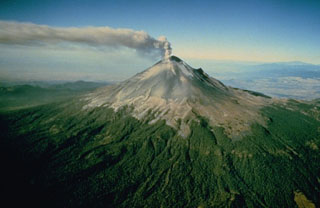Report on Popocatepetl (Mexico) — 12 September-18 September 2018
Smithsonian Institution / US Geological Survey
Weekly Volcanic Activity Report, 12 September-18 September 2018
Managing Editor: Sally Sennert.
Please cite this report as:
Global Volcanism Program, 2018. Report on Popocatepetl (Mexico) (Sennert, S, ed.). Weekly Volcanic Activity Report, 12 September-18 September 2018. Smithsonian Institution and US Geological Survey.
Popocatepetl
Mexico
19.023°N, 98.622°W; summit elev. 5393 m
All times are local (unless otherwise noted)
CENAPRED reported that each day during 12-17 September there were 64-189 steam-and-gas emissions from Popocatépetl, some of which contained minor amounts of ash. Nighttime crater incandescence was sometimes visible. Explosions were detected almost every day: eight on 12 September; one on 14 September; five on 15 September; three on 16 September. A series of emissions and explosions accompanied by tremor began at 0425 on 17 September and lasted for 365 minutes; incandescent tephra was ejected. The Alert Level remained at Yellow, Phase Two.
Geological Summary. Volcán Popocatépetl, whose name is the Aztec word for smoking mountain, rises 70 km SE of Mexico City to form North America's 2nd-highest volcano. The glacier-clad stratovolcano contains a steep-walled, 400 x 600 m wide crater. The generally symmetrical volcano is modified by the sharp-peaked Ventorrillo on the NW, a remnant of an earlier volcano. At least three previous major cones were destroyed by gravitational failure during the Pleistocene, producing massive debris-avalanche deposits covering broad areas to the south. The modern volcano was constructed south of the late-Pleistocene to Holocene El Fraile cone. Three major Plinian eruptions, the most recent of which took place about 800 CE, have occurred since the mid-Holocene, accompanied by pyroclastic flows and voluminous lahars that swept basins below the volcano. Frequent historical eruptions, first recorded in Aztec codices, have occurred since Pre-Columbian time.
Source: Centro Nacional de Prevencion de Desastres (CENAPRED)

